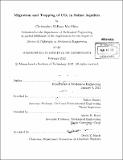Migration and trapping of CO₂ in saline aquifers
Author(s)
MacMinn, Christopher William
DownloadFull printable version (16.23Mb)
Alternative title
Migration and trapping of carbon dioxide in saline aquifers
Other Contributors
Massachusetts Institute of Technology. Dept. of Mechanical Engineering.
Advisor
Ruben Juanes.
Terms of use
Metadata
Show full item recordAbstract
Mitigation of climate change requires a reduction in atmospheric carbon dioxide (C0 2) emissions. One promising tool for achieving this is the large-scale injection of CO2 into deep saline aquifers. After injection, upward leakage of the CO2 is a primary concern because it will be buoyant relative to the ambient groundwater and, as a result, will rise toward the top of the aquifer and may migrate laterally away from the injection site. To assess leakage risks and estimate aquifer capacity requires an accurate understanding of the subsurface migration and trapping of the buoyant C0 2; however, many aspects of the fundamental physics of CO 2 migration and trapping are not fully understood, and traditional reservoir-simulation tools are currently unable to resolve the impact of small-scale trapping processes on these large-scale fluid flows. In this Thesis, we develop a simple gravity-current model for the post-injection migration and trapping of a buoyant plume of CO2 in a confined, sloping saline aquifer with a natural groundwater through-flow. We include both residual trapping, where small blobs of CO 2 are immobilized by capillarity along the trailing edge of the plume, and solubility trapping driven by convective dissolution, where CO2 dissolves into the groundwater and sinks downward in dense, C0 2-rich fingers. Although idealized, this model offers physical insight into the processes controlling CO 2 migration and trapping, and is not limited by computational resources. We derive solutions to the model in several limiting cases, and we use these solutions to study the interplay between slope and groundwater flow, and the competition between residual and solubility trapping. We validate the model against laboratory analog experiments, finding good agreement between the experimental results and the predictions of the model. We then use the experiments to study the small-scale dynamics of the convective-dissolution instability: the formation, descent, and coarsening of the fingers. Finally, we use the model to study the migration and trapping of CO 2 in the Mt. Simon Sandstone, a large deep saline aquifer in the Midwestern United States that is considered to be a promising candidate for geological CO 2 storage.
Description
Thesis (Ph. D.)--Massachusetts Institute of Technology, Dept. of Mechanical Engineering, 2012. Cataloged from PDF version of thesis. Includes bibliographical references (p. 123-128).
Date issued
2012Department
Massachusetts Institute of Technology. Department of Mechanical EngineeringPublisher
Massachusetts Institute of Technology
Keywords
Mechanical Engineering.